Related Research Articles

Kotonishiki Katsuhiro is a former sumo wrestler from Takasaki, Gunma Prefecture, Japan. He began his career in 1984, reaching the top makuuchi division in 1989. He won two top division tournament titles from the maegashira ranks, the first in 1991 and the second in 1998. His highest rank was sekiwake, which he held 21 times. He earned eighteen special prizes during his career, second on the all-time list, and defeated yokozuna eight times when ranked as a maegashira. He retired in 2000 and after a long stint as a sumo coach at Oguruma stable, took the vacant elder name Asahiyama and branched out to form his own stable of the same name.

Kaiketsu Masateru was a Japanese sumo wrestler, who reached the second highest rank of ōzeki on two occasions. He also won two top division tournament championships. After his retirement in 1979 he became a coach under the name of Hanaregoma-oyakata and established Hanaregoma stable. He was also chairman of the Japan Sumo Association from 2010 to 2012.

Dejima Takeharu is a former sumo wrestler from Kanazawa, Ishikawa, Japan. A former amateur champion, he made his professional debut in 1996, reaching the top makuuchi division the following year. In July 1999 he won the yūshō or tournament championship and earned promotion to the second highest rank of ōzeki. He lost the rank in 2001 and, for the most part, remained a maegashira until his retirement in 2009. He won ten special prizes and six gold stars over his long career. He wrestled for Musashigawa stable. He is now an elder of the Japan Sumo Association under the name Ōnaruto Oyakata.
Wakanami Jun was a sumo wrestler from Iwai, Ibaraki, Japan. His highest rank was komusubi. He won a top division tournament championship in March 1968. He was also a sumo coach.
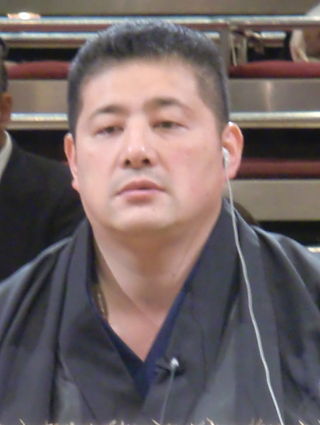
Kotonowaka Terumasa, born May 15, 1968, as Konno Mitsuya, is a former sumo wrestler from Obanazawa, Yamagata prefecture, Japan. He made his professional debut in 1984 and after reaching the top makuuchi division in 1990 he remained there for 15 years until his retirement in 2005. His highest rank was sekiwake and he earned seven special prizes and eight gold stars during his long makuuchi career. He is now the head coach of Sadogatake stable.
Tochiazuma Tomoyori is a former sumo wrestler from Sōma, Fukushima Prefecture, Japan. His highest rank was sekiwake, which he held for one tournament in 1970. He won the top division championship in January 1972. After retirement he worked as a coach at his stable, Kasugano, until 1990 when he set up his own Tamanoi stable. He is the father of the former ōzeki Tochiazuma Daisuke, and upon his retirement as a coach in 2009 his son took over from him.

Fujinishiki Akira was a sumo wrestler from Kofu, Yamanashi, Japan. His highest rank was komusubi, which he held on ten occasions. He won the top makuuchi division tournament championship or yūshō in 1964 and was runner-up in two other tournaments. He won seven special prizes and seven gold stars for defeating yokozuna. After his retirement in 1968 he was an elder of the Japan Sumo Association and was the head coach of Takasago stable from 1988 until shortly before his retirement from the Sumo Association in 2002. He died of liver disease in 2003.
Kotofuji Takaya is a former sumo wrestler from Chiba City, Japan. His highest rank was sekiwake. In 1991 he won a top division yūshō or tournament championship from the maegashira ranks.
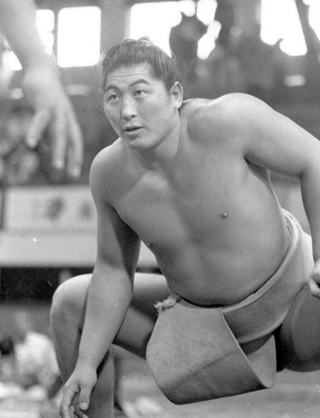
Kiyokuni Katsuo is a former sumo wrestler from Ogachi, Akita, Japan. His highest rank was ōzeki, which he held from 1969 to 1974. He won one top division yūshō or tournament championship and was a runner-up in five other tournaments. He also earned seven special prizes and seven gold stars. After his retirement he was the head coach of Isegahama stable.
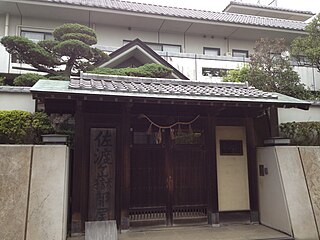
Sadogatake stable is a stable of sumo wrestlers, one of the Nishonoseki group of stables. In its modern form, it dates from September 1955, when it was set up by former komusubi Kotonishiki Noboru. Former yokozuna Kotozakura took over the running of the stable in 1974 following Kotonishiki's death. The stable is located in Matsudo, Chiba prefecture. Over the next thirty years the stable produced a string of top division wrestlers. Kotozakura stood down in November 2005, handing the stable over to his son-in-law, former sekiwake Kotonowaka.
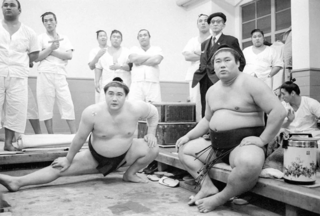
Daikirin Takayoshi, born Masakatsu Tsutsumi, was a sumo wrestler from Saga Prefecture, Japan. He began his professional career in 1958 and reached his highest rank of ōzeki twelve years later in 1970. He retired in 1974, and until June 2006 he was an elder of the Sumo Association under the name Oshiogawa.

Masuiyama Daishirō was a sumo wrestler from Himeji, Hyōgo, Japan. His highest rank was ōzeki. After his retirement he was the head coach of Mihogaseki stable and produced yokozuna Kitanoumi among other wrestlers.

Myōbudani Kiyoshi was a Japanese sumo wrestler from Akan, Hokkaido. He was a member of Miyagino stable. His highest rank was sekiwake and he twice took part in playoffs for the top makuuchi division tournament championship or yūshō. He was also a runner-up in two other tournaments. He earned eight sanshō, or special prizes, for his achievements in tournaments; four for Outstanding Performance and four for Fighting Spirit. He also earned three kinboshi, or gold stars, for defeating yokozuna. After his retirement in 1969 he was an elder of the Japan Sumo Association but left the sumo world in 1977 to become a Jehovah's Witness.
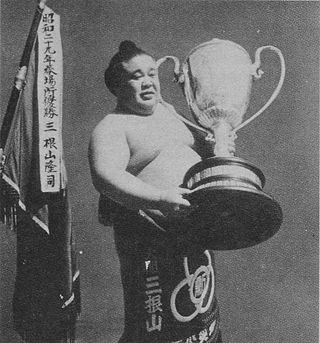
Mitsuneyama Keiji, real name Tōichi Shimamura was a sumo wrestler from Arakawa, Tokyo, Japan who won the top division yūshō or tournament championship in 1954. His highest rank was ōzeki and he earned nine kinboshi or gold stars for defeating yokozuna when ranked as a maegashira, and seven special prizes. After his retirement in 1960 he was the head coach of Takashima stable.
The following are the events in professional sumo during 2009.
The following are the events in professional sumo during 2007.
The following are the events in professional sumo during 2006.
The following are the events in professional sumo during 2002.
Kurohimeyama Hideo, born as Hideo Tanaka, was a sumo wrestler from Ōmi, Niigata, Japan.
Fukunohana Koichi is a former sumo wrestler from Kōshi, Kumamoto, Japan. He made his professional debut in January 1958 and reached the top division in September 1965. His highest rank was sekiwake. He retired in November 1975.
References
- ↑ "Hasegawa Katsuhiro Rikishi Information". Sumo Reference. Retrieved 26 August 2012.